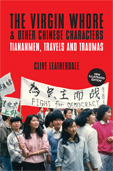
by Clive Leatherdale (2009), Illustrated
Paperback. 234x156mm
248 pages
The 1993 hardback and 2003 paperback editions are out of print
ISBN 978- 1-905328-61-1
£11.99
The 20th anniversary of the Tiananmen massacre fell on June 4th, 1999. The author found himself caught up in those student uprisings. His travels and traumas are detailed in this entertaining, and often biting, account of China as it was in 1989 and 1990.
"Clive Leatherdale turned up in Shanghai as a teacher. It wasn't a place he would have chosen to go, which makes this unusual among travel books; perhaps it's the friction between his sense of where he is and where he would rather be that makes The Virgin Whore and Other Chinese Characters so good. Naturally, he manages to muster up a strange affection for the place, much as anyone big-hearted enough could probably learn to love hell. He is best at trying to get along with people, and his attempt to unpick the Chinese character manages to be comic without being condescending. Exasperated by his students' tendency to pillage published works for essays, he sets them an essay on the dangers of plagiarism. They all turn in essays on plagiarism directly copied from the work of previous writers. He gives top marks to the student who has written the most incomprehensible essay, on the grounds that he couldn't have lifted it from anywhere. But the book has its serious side: Leatherdale waas in China around the time of the Tiananmen Square massacre and evokes a people stunned by the dead hand of the government." The Independent on Sunday.
Note on the 2009 edition:
Twenty years have passed since I was pitched into a Shanghai about
to explode. I was set to experience perhaps the most dramatic
100 days of my life. If at this distance in time those events
seem unreal, it is largely because the China of 1989 has been
swept away. Those who go there today can have little inkling of
what it was like. The east bank of the Huangpu River, for example,
was mostly flat fields. Now it boasts the new city of Pudong.
In 1989 my camera recorded only a few skyscrapers, now television
reveals a multitude. There was no metro in 1989. Getting around,
inside and outside Shanghai, was hard. Bicycles were the only
means of personal transport, Mao blue was the predominant colour,
and questionable ethics pervaded almost every aspect of life into
which I came in contact.
My 100 days in Shanghai climaxed with forced evacuation after
the events in Tiananmen Square. After a brief interlude in the
Philippines I returned to China, to Guangzhou (Canton), for a
further year. This enabled a wider perspective, even if it did
not encourage greater sympathy. Chinese suffered in ways big and
small at the hands of other Chinese, many of its historic treasures
had been destroyed during the Cultural Revolution and, as confirmed
by the franker guidebooks, China’s cities of the time were
almost unspeakably grim. Most Chinese ‘beauty spots’
were nothing of the kind.
For someone enraptured by her neighbours, Japan and Korea, the
harsh reality of life in China offered a stark and unwelcome contrast.
Revisiting my words, I am reminded of my disappointment and disillusion.
Back in the UK I would give illustrated lectures and take questions
at the end. The commonest of these was: ‘Didn’t you
find anything positive at all about China?’ This surprised
me, for I thought I had said much that was positive.
It would be unfair to amend my text, so I haven’t.